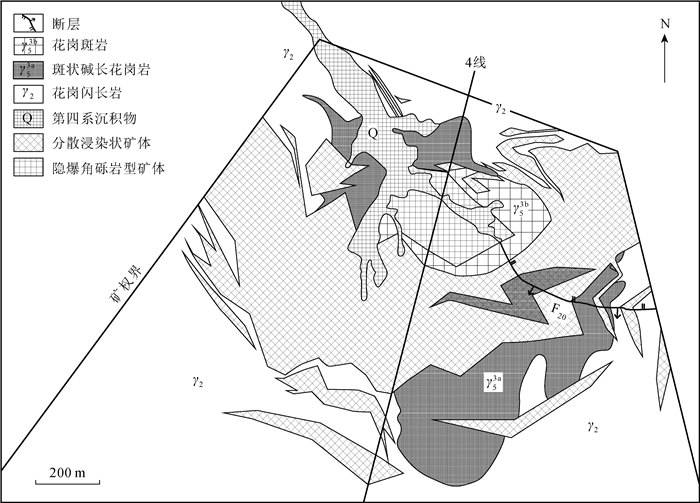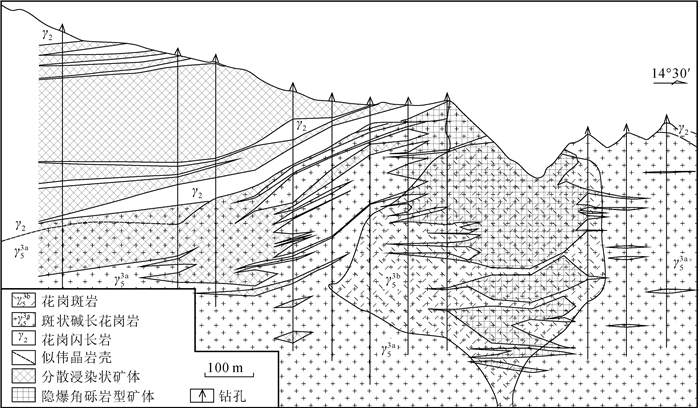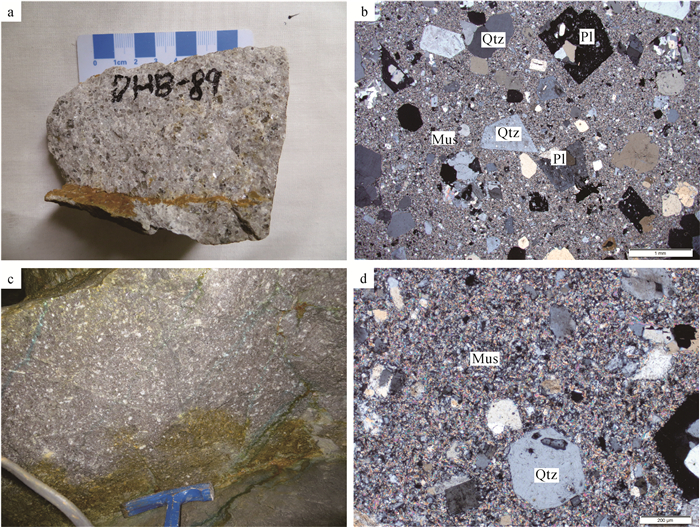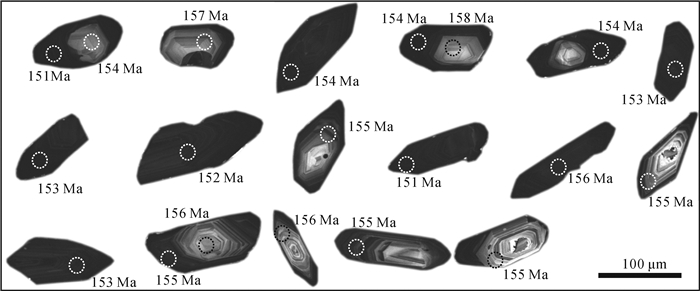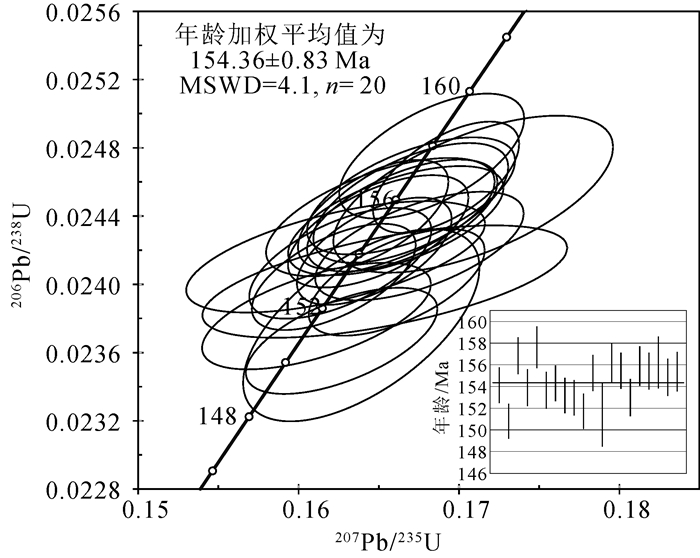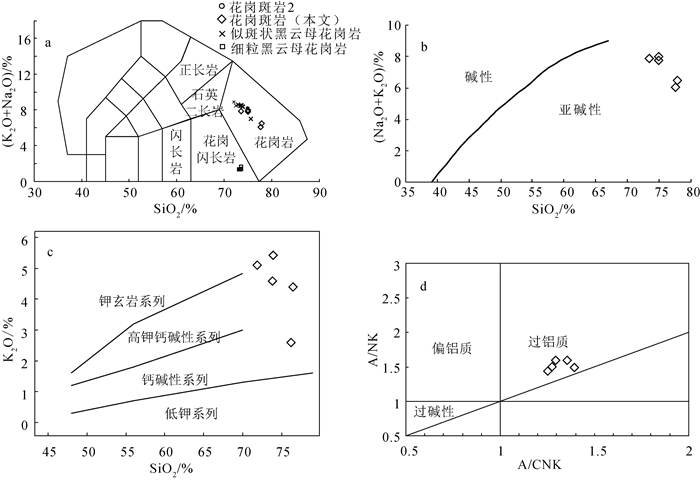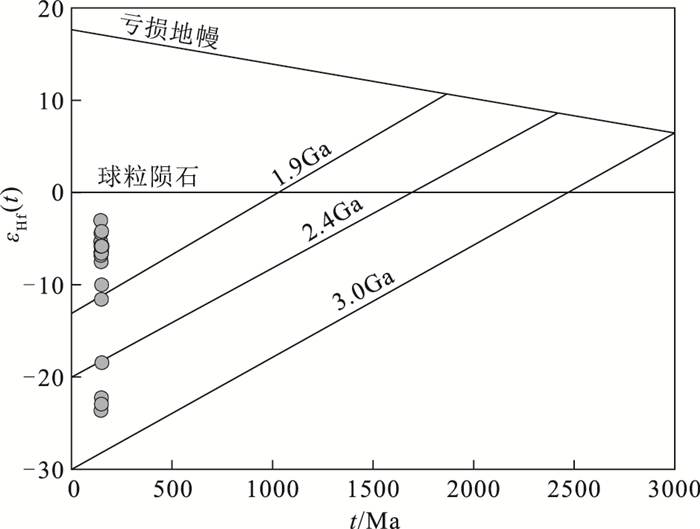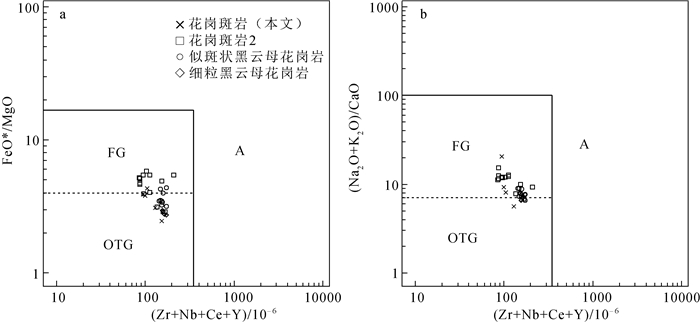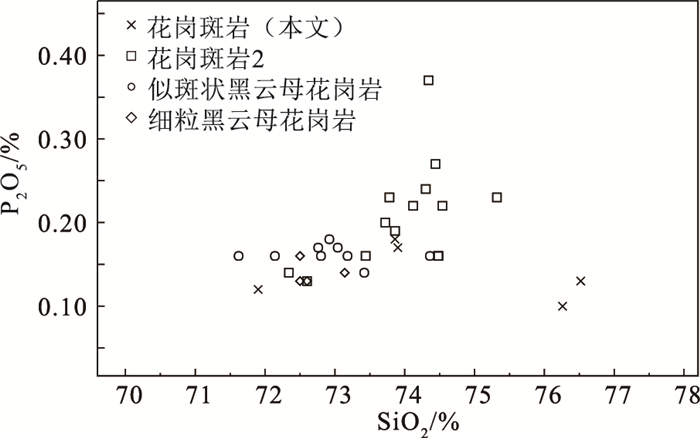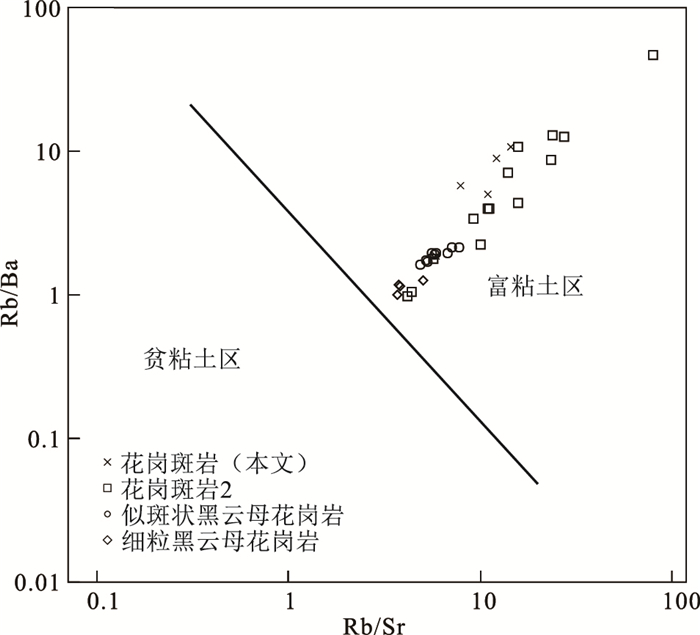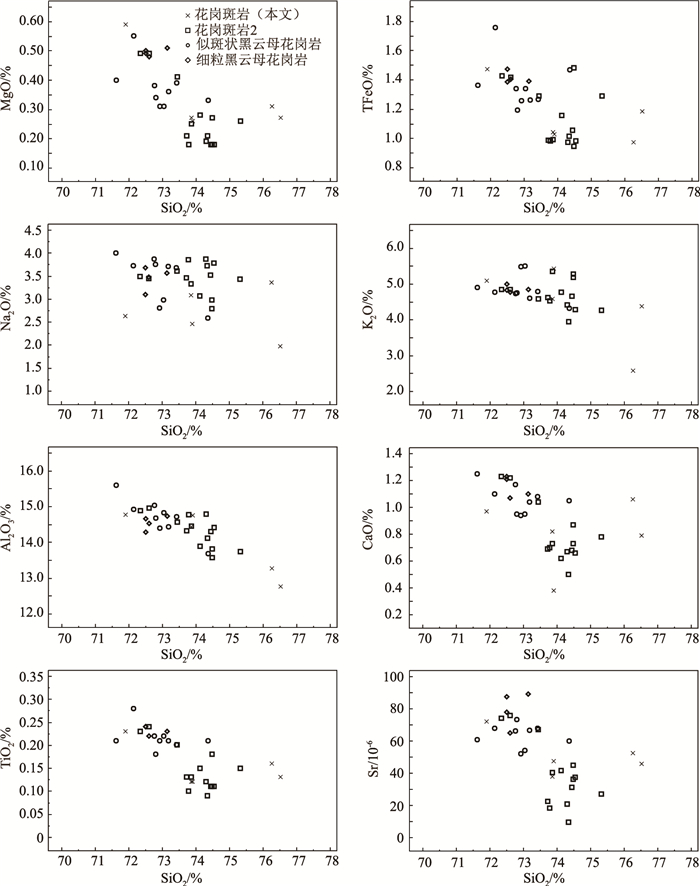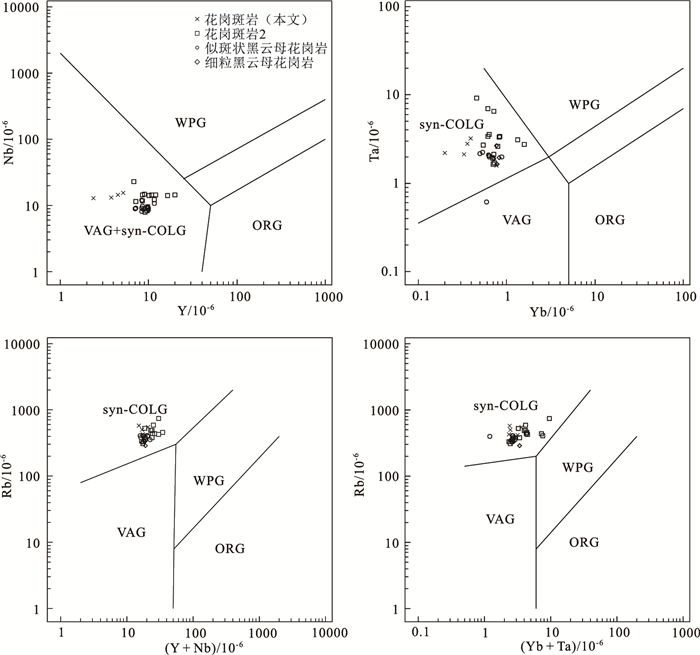Zircon U-Pb age, geochemistry and Hf isotope characteristics of Shimensi granite porphyry in northern Jiangxi Province and its constraint on mineralization
-
摘要:
大湖塘钨矿田石门寺矿段钨多金属矿成矿作用与燕山期花岗质岩浆活动密切相关。其中燕山期花岗斑岩与热液隐爆角砾岩关系密切,是重要的成矿地质体。为研究该岩体成岩时代、岩石成因与演化、形成背景,探讨岩体与成矿的关系,对石门寺花岗斑岩开展了系统的岩相学、岩石化学、锆石U-Pb年龄及Hf同位素研究。结果表明,花岗斑岩形成年龄为154.36±0.83 Ma;花岗斑岩为高硅(SiO2含量为71.90%~76.53%)、过铝质(Al2O3含量为12.76%~14.76%,A/CNK值为1.25~1.39)、高钾钙碱性系列(K2O含量为2.58%~5.42%)岩石;富集大离子亲石元素,亏损高场强元素,稀土元素含量(49.38×10-6~72.36×10-6)较低、LREE/HREE(9.83~16.76)和(La/Yb)N值(16.43~39.45)较高,呈明显负Eu(δEu=0.27~0.65)异常;岩石类型为S型花岗岩。锆石的εHf(t)值为-23.6~-2.9,二阶段模式年龄为1.39~2.70 Ga,表明石门寺花岗斑岩可能为古老地壳部分熔融的产物。岩浆源岩主要为富粘土物质;岩浆演化过程中经历了镁铁质矿物、钛铁矿、斜长石的分离结晶,磷灰石没有发生显著分离结晶作用。结合区内中生代成矿地球动力学背景分析,九岭-鄣公山隆起带存在2期重要的成矿作用:①约150 Ma,由于太平洋板块俯冲汇聚而产生的挤压构造背景下的成岩成矿作用;②约135 Ma以来,处于区域岩石圈伸展减薄背景下的钨多金属成矿作用。
Abstract:The mineralization of tungsten polymetallic ore in the Dahutang tungsten orefield is closely related to the Yanshanian granitic magmatism.The Yanshanian granite porphyry is closely related to the hydrothermal cryptoexplosion breccia and is an important ore-forming geological body in this area.In order to study the rock-forming age, genesis, evolution and formation background of the rock mass as well as to discuss the relationship between the rock mass and mineralization, the authors carried out a systematic study in the aspects of petrology, major and trace elements, zircon U-Pb geochronology and Hf isotope for the Shimensi granite porphyry.The research results show that the rock-forming age of granite porphyry is 154.36±0.83 Ma, the granite porphyry has high-silicon(the content of SiO2 is 71.90%~76.53%), peraluminous nature(the content of Al2O3 being 12.76%~14.76% and the A/CNK value being 1.25~1.39)and thus belongs to high-potassium-calcium-alkaline series(the content of K2O is 2.58%~5.42%).The granite porphyry is enriched in LILEs and depleted in HFSEs.The REE content is low(49.38×10-6~72.36×10-6), LREE/HREE(9.83~16.76)and(La/Yb)N(16.43~39.45)are high, and the granite porphyry has obviously negative δEu anomaly(0.27~0.65).The rock type of granite porphyry is S-type.The εHf(t)values of zircons are -23.6~-2.9 and the two-stage model ages are 1.39~2.70 Ga, indicating that the Shimensi granite porphyry may be a product of partial melting of ancient crust.The source rock magma is mainly clay-rich material.During the evolution of magma, the separation and crystallization of mafic minerals, ilmenite and plagioclase occurred, and no significant separation and crystallization of apatite occurred.Combined with the Mesozoic metallogenic tectonic background in this area, there existed two important mineralization events in the Jiuling-Zhanggongshan uplift zone:one occurred at about 150 Ma, as a result of the diagenetic mineralization under the extrusion tectonic background of the subduction of the Pacific plate; the second occurred at about 135 Ma, as a result of tungsten polymetallic mineralization under the background of the lithosphere stretching thinning.
-
Keywords:
- Dahutang tungsten orefield /
- Shimensi granite porphyry /
- zircon U-Pb age /
- geochemistry /
- Hf isotope
-
大湖塘钨矿床是中国近年来发现的一个超大型钨矿床,矿床产于赣北钨铜多金属矿集区内的九岭-鄣公山多金属成矿带上,北侧为九江-瑞江(九瑞)铜多金属成矿带,南侧是钦杭结合带的重要组成部分:德兴-东乡铜多金属成矿带和位于华夏板块西北缘的北武夷铜(钼)铅锌多金属成矿带。相关研究表明,九岭-鄣公山多金属成矿带主要经历了古元古代扬子古克拉通的形成、中—新元古代扬子与华夏板块的聚合与裂解、早古生代褶皱的隆升、晚古生代局部的裂陷作用和中生代的板内构造变形作用[1]。伴随大规模的构造-岩浆作用,该区发育了一系列钨锡铜金多金属矿床,包括香炉山钨矿、大湖塘钨矿、阳储岭钨钼矿、曾家垅锡矿、村前铜矿、大背坞金矿等。
前人对九岭-鄣公山多金属成矿带主要矿床及成矿岩体的研究表明,该区成岩成矿时代主要集中在140~150 Ma和110~130 Ma[2-6]。大湖塘钨矿石门寺矿段和狮尾洞矿段的辉钼矿等时线年龄分别为143.7±1.2 Ma和140.9±3.6 Ma[5],矿区似斑状白云母花岗岩岩体的锆石U-Pb年龄为144.2±1.3 Ma[6];与成矿有关的花岗岩为强过铝质的S型花岗岩[6]。
矿体的空间分布有3种形式:似斑状花岗岩和新元古代花岗闪长岩的内外接触带(以外接触带为主)是本矿区钨矿体最重要的赋矿部位;细粒花岗岩内外接触带是本矿区钨铜矿体的重要赋矿部位;花岗斑岩的内外接触带(主要在外接触带),特别是斑岩体前锋位置的爆破角砾岩,是铜矿体和钨铜矿体的重要赋矿部位。矿体与岩体的空间关系表明,花岗斑岩与成矿更密切。
为进一步深化对九岭-鄣公山多金属成矿带成矿作用的研究,本次选取赣北大湖塘钨矿区内与钨、铜、钼成矿密切相关的石门寺花岗斑岩开展了基础地质、岩相学、岩石化学、单颗粒锆石U-Pb定年和原位Hf同位素研究,并结合区域成矿作用研究成果,进一步探讨其形成的地质背景,为深入揭示九岭-鄣公山成矿带的成矿规律、实现找矿突破提供了理论依据。
1. 区域地质背景
九岭-鄣公山成矿带是在扬子板块东南缘中—新元古代裂谷及造山作用的基础上,经历古生代坳陷及中生代强烈的挤压隆升作用形成的构造岩浆成矿带(图 1)。
![]() 图 1 江西北部大湖塘钨矿区地质简图[6]Figure 1. Geological map of the Dahutang tungsten deposit in northern Jiangxi Province
图 1 江西北部大湖塘钨矿区地质简图[6]Figure 1. Geological map of the Dahutang tungsten deposit in northern Jiangxi Province区内发育的地层主要为中元古界低绿片岩相变质岩岩系和下古生界沉积建造;前者为一套巨厚的以泥砂质细碎屑为主的灰色浅变质岩系,上部、下部以凝灰岩为主夹少量细碧岩、石英角斑岩等,具有较高的铜、金、钼等;下古生界为一套含火山喷气或喷发物质的碎屑岩、碳酸盐岩建造,是铜、钨多金属的有利赋矿层位,其中香炉山式超大型钨矿床赋存在寒武系—奥陶系中;岩浆岩主要为中元古代晚期海相细碧角斑岩建造,晋宁期(如九岭大型复式花岗岩岩基)和燕山期中酸性、酸性侵入岩。构造主要为EW向修水-德安-波阳断裂及NNE向宜丰-景德镇断裂,这2条大断裂是九岭隆起带边界断裂、九岭南缘近EW向、高台山-鄣公山南东缘NE—NNE向及德安弧形推(滑)覆构造等;同时发育武宁-修水、铜鼓-奉新、永修-新建、浮梁-藏湾等韧(脆)性剪切带,且不同程度地控制了区内岩浆作用、钨钼铜等多金属成矿作用。
区内发育的内生金属矿床以钨、锡、金、铜等为主,其次为钼、铅锌、铌钽等,主要在九岭-鄣公山隆起带周缘大规模的花岗杂岩区产出,并在隆起带北侧构成了大湖塘-云山-茅棚店-鄣公山重要的EW向钨锡多金属成矿带。
2. 矿床地质特征
矿床地质研究揭示,大湖塘钨矿区发育的地层为中元古界双桥山群安乐林组、蓟县系双桥山群修水组(Jxx)。岩浆岩主要是中新元古代黑云母花岗闪长岩(九岭岩基的一部分,约占矿区总面积的80%)(图 2)[8],出露面积达2300 km2,呈EW向展布;其次是晚侏罗世—早白垩世斑状黑云母二长花岗岩、细粒二云花岗岩和花岗斑岩。黑云母二长花岗岩主要以岩株、岩瘤和岩床形式产出,多分布在石门寺矿段中部,出露面积约1.7 km2;细粒二云花岗岩出露面积约0.16 km2,以小岩株形式产出;花岗斑岩在地表、钻孔中呈脉状产出,与热液隐爆角砾岩型钨钼矿化关系密切(图 3)。地表露头及单个勘查工程中所见花岗斑岩体形态亦极不规则,常呈脉状膨大缩小、分枝复合,厚的几十至二百余米,薄的仅几厘米,倾向不定,倾角陡缓不一。但总体上呈2组脉群,一组为走向NW、倾向NE,另一组为走向NE、倾向NW,倾角均较陡,受成矿期NW向和NE向2个扭性断裂限制。
![]() 图 2 石门寺钨矿床地质简图[7]Figure 2. Geological map of the Shimensi tungsten deposit
图 2 石门寺钨矿床地质简图[7]Figure 2. Geological map of the Shimensi tungsten deposit已有的地质勘探结果显示,石门寺矿段钨矿体呈透镜状、筒状、似层状和脉状分布于燕山中期花岗岩体上部及外接触带300~600 m范围内。金属矿物主要有黑钨矿、白钨矿、黄铜矿、辉钼矿;脉石矿物包括方解石、石英。矿石结构主要有交代结构和固溶体分离结构,矿石构造主要为脉状构造、角砾状构造、浸染状构造等。常见的围岩蚀变主要有云英岩化、钾长石化、黑鳞云母化、绿泥石化、硅化、黄铁矿化,另外还有少量绢云母化、碳酸盐化。其中,云英岩化和硅化与钨、钼、铜矿化关系尤为密切。
3. 采样及测试方法
实验样品采自大湖塘钨矿田石门寺花岗斑岩,采集地表、坑道出露的新鲜花岗斑岩(DHB-87、DHB-89、DHC-176、DHC-331、DHC-1),岩石呈浅灰色,为斑状结构、块状构造。斑晶以斜长石(10%~15%)和石英(约20%)为主;基质主要为钾长石,其次为斜长石、石英等(图 4);副矿物有磁铁矿、磷灰石、锆石等。
3.1 锆石U-Pb定年和Hf同位素
锆石分选在河北省廊坊市区域地质调查研究所完成,采用常规粉碎、浮选和电磁选方法进行分选,制靶、阴极发光显微照相、透射光及反射光照相在北京锆年领航科技有限公司完成。锆石U-Pb同位素在天津地质调查中心实验室利用LA-ICP-MS方法测定,锆石定年所用仪器为Thermo Fisher公司制造的Neptune多接收电感耦合等离子体质谱仪及与之配套的New wave UP 193 nm激光剥蚀系统(LA-MC-ICP-MS)。利用193 nm FX激光器对锆石进行剥蚀,激光剥蚀的斑束直径为35 μm,激光剥蚀样品的深度为20~40 μm。锆石年龄计算采用国际标准锆石91500为外标,元素含量采用人工合成硅酸盐玻璃NIST SRM610为外标,29Si为内标元素进行校正。数据处理采用ICP MS Data Cal程序[9-10]和Isoplot程序[11]进行锆石年龄加权平均值计算及谐和图绘制。
锆石Hf同位素分析是在锆石U-Pb定年测试的基础上,针对获得的谐和年龄原位测试Lu-Hf同位素。实验在天津地质调查中心实验室LA-MC-ICP-MS上完成,使用的激光束斑直径为50 μm,激光剥蚀时间为26 s,采用锆石GJ-1标准,详细测试流程、仪器运行条件等见参考文献[12]。测试中GJ-1的176Hf/177Hf和176Lu/177Hf值分别为0.281988±18(2σn,n=19)和0.0003,在误差范围内一致[13]。
3.2 全岩地球化学
将新鲜样品在无污染状态下,粉碎至200目以下(约150 g),测试分析工作在核工业北京地质研究院分析测试中心完成。主量元素使用AB-104L,PW2404X射线荧光光谱仪测定;微量和稀土元素使用ELEMENT XR等离子体质谱分析仪进行测定。详细的样品消解处理过程、分析精密度和准确度据参考文献[14]。
4. 分析结果
4.1 锆石U-Pb年龄
本次获得的锆石形态大小不等,所测锆石以自形椎柱状为主,长宽比为1:1~3:1,具有较明显的振荡环带结构,基本属于岩浆锆石特征(图 5)。20颗锆石的U-Pb同位素数据均在谐和线上或其附近,年龄变化于151~158 Ma之间(表 1),年龄加权平均值为154.36±0.83 Ma(n= 20,MSWD=4.1)(图 6),代表了该岩体的岩浆结晶年龄。
表 1 石门寺花岗斑岩LA-ICP-MS锆石U-Th-Pb同位素数据Table 1. LA-ICP-MS zircon U-Th-Pb dating results for the Shimensi granite prophyry样品号 含量/10-6 同位素比值 年龄/Ma Pb U 206Pb/238U 1σ 207Pb/235U 1σ 207Pb/206Pb 1σ 208Pb/232Th 1σ 232Th/238U 1σ 206Pb/238U 1σ 207Pb/235U 1σ 207Pb/206Pb 1σ 1 12 446 0.0242 0.0001 0.1647 0.0020 0.0494 0.0007 0.0072 0.0010 0.6112 0.0009 154 1 155 2 166 31 2 190 8640 0.0237 0.0001 0.1627 0.0024 0.0499 0.0008 0.0271 0.0006 0.0196 0.0004 151 1 153 2 188 36 3 55 2227 0.0246 0.0001 0.1692 0.0019 0.0498 0.0006 0.0204 0.0007 0.1336 0.0007 157 1 159 2 187 29 4 184 8130 0.0242 0.0001 0.1623 0.0038 0.0487 0.0012 0.0225 0.0002 0.0360 0.0003 154 1 153 4 135 55 5 24 983 0.0248 0.0001 0.1683 0.0024 0.0493 0.0007 0.0072 0.0020 0.2853 0.0015 158 1 158 2 163 32 6 409 18255 0.0241 0.0001 0.1626 0.0023 0.0489 0.0007 0.0437 0.0016 0.0137 0.0003 154 1 153 2 142 35 7 206 9043 0.0242 0.0001 0.1675 0.0027 0.0502 0.0008 0.0405 0.0004 0.0213 0.0001 154 1 157 2 202 38 8 130 4641 0.0240 0.0001 0.1622 0.0021 0.0489 0.0007 0.0086 0.0024 0.8061 0.0016 153 1 153 2 144 32 9 185 8102 0.0240 0.0001 0.1661 0.0022 0.0502 0.0007 0.0403 0.0006 0.0281 0.0008 153 1 156 2 203 33 10 111 5013 0.0238 0.0001 0.1611 0.0029 0.0491 0.0009 0.0083 0.0020 0.0682 0.0003 152 1 152 3 151 43 11 54 2193 0.0244 0.0001 0.1661 0.0027 0.0494 0.0009 0.0251 0.0010 0.1180 0.0011 155 1 156 3 168 40 12 116 5247 0.0238 0.0002 0.1639 0.0030 0.0500 0.0008 0.0167 0.0010 0.0342 0.0002 151 1 154 3 197 36 13 85 3392 0.0245 0.0001 0.1670 0.0027 0.0494 0.0008 0.0536 0.0013 0.0569 0.0003 156 1 157 2 167 35 14 44 1834 0.0244 0.0001 0.1647 0.0019 0.0489 0.0006 0.0254 0.0004 0.0941 0.0009 155 1 155 2 144 29 15 124 5614 0.0240 0.0001 0.1654 0.0046 0.0499 0.0014 0.0092 0.0003 0.0416 0.0001 153 1 155 4 192 66 16 15 605 0.0245 0.0001 0.1670 0.0025 0.0495 0.0007 0.0078 0.0004 0.4135 0.0034 156 1 157 2 171 34 17 80 3458 0.0244 0.0001 0.1665 0.0024 0.0495 0.0008 0.0106 0.0016 0.1120 0.0007 155 1 156 2 170 36 18 20 802 0.0245 0.0002 0.1709 0.0036 0.0505 0.0009 0.0145 0.0007 0.1976 0.0005 156 1 160 3 219 43 19 54 2266 0.0243 0.0001 0.1650 0.0023 0.0492 0.0007 0.0142 0.0020 0.1413 0.0010 155 1 155 2 158 35 20 73 3131 0.0244 0.0001 0.1651 0.0029 0.0491 0.0009 0.0146 0.0004 0.0806 0.0009 155 1 155 3 152 42 4.2 岩石地球化学特征
4.2.1 主量元素
大湖塘钨矿石门寺矿段花岗斑岩岩体的5件全岩样品的主量元素分析结果如表 2所示,烧失量均小于3%。
表 2 石门寺花岗斑岩主量、微量和稀土元素分析结果Table 2. Major, trace elements and REE compositions of Shimensi granite porphyry样号 DHB-87 DHB-89 DHC-176 DHC-331 DHY-1 SiO2 76.53 76.27 73.86 73.90 71.90 TiO2 0.13 0.16 0.12 0.12 0.23 Al2O3 12.76 13.27 14.42 14.74 14.76 Fe2O3 0.40 0.25 0.17 0.40 0.49 FeO 0.80 0.73 0.87 0.65 1.00 MnO 0.05 0.03 0.05 0.05 0.05 MgO 0.27 0.31 0.27 0.26 0.59 CaO 0.79 1.06 0.82 0.38 0.97 Na2O 1.97 3.36 3.08 2.45 2.62 K2O 4.38 2.58 4.57 5.42 5.08 P2O5 0.13 0.10 0.18 0.17 0.12 烧失量 1.21 1.28 1.00 0.92 1.64 总计 98.21 98.12 98.41 98.54 97.81 K2O+NaO 6.35 5.94 7.65 7.87 7.70 Na2O/K2O 0.45 1.30 0.67 0.45 0.52 σ 1.20 1.06 1.90 2.00 2.05 A/CNK 1.36 1.30 1.25 1.39 1.28 A/NK 1.60 1.60 1.44 1.49 1.51 锆饱和温度/℃ 726.03 742.77 708.25 718.9 759.72 Cs 138.00 85.20 125.00 100.00 158.00 Rb 497.00 418.00 548.00 574.00 426.00 Ba 98.70 72.40 50.70 64.70 229.00 Th 10.40 11.40 8.07 7.94 12.60 U 10.70 11.00 13.60 6.37 6.09 Nb 13.30 14.60 15.60 12.80 9.05 Ta 2.14 2.81 3.22 2.21 1.58 K 36360 21417 37937 44994 42171 Sr 45.60 52.50 37.60 47.30 71.80 P 567.35 436.42 785.56 741.92 523.70 Zr 59.20 77.70 53.90 55.80 104.00 Hf 2.28 2.88 2.20 2.26 3.35 Ti 779.15 958.95 719.21 719.21 1378.4 La 14.60 15.70 11.70 11.00 15.70 Ce 28.90 32.60 24.40 22.90 30.80 Pr 3.20 3.64 2.73 2.50 3.27 Nd 11.70 14.00 9.86 8.48 12.90 Sm 2.12 2.58 1.96 1.58 2.49 Eu 0.27 0.33 0.16 0.14 0.52 Gd 1.80 2.06 1.65 1.30 2.38 Tb 0.22 0.22 0.22 0.17 0.35 Dy 0.94 1.05 1.21 0.69 1.75 Ho 0.15 0.18 0.20 0.11 0.32 Er 0.37 0.43 0.46 0.25 0.88 Tm 0.05 0.06 0.06 0.03 0.12 Yb 0.33 0.36 0.39 0.20 0.77 Lu 0.05 0.05 0.05 0.03 0.11 Y 3.79 4.51 5.12 2.38 8.42 ∑REE 64.70 73.26 55.06 49.38 72.36 ∑LREE/∑HREE 15.56 15.62 11.96 16.76 9.83 (La/Yb)N 31.74 31.28 21.52 39.45 14.63 δEu 0.42 0.44 0.27 0.30 0.65 (Gd/Yb)N 4.51 4.73 3.50 5.38 2.56 注:A/CNK=Al2O3/(CaO+Na2O+K2O); A/NK= Al2O3/(Na2O+K2O);主量元素含量单位为%,微量和稀土元素含量单位为10-6 5件样品的SiO2含量为71.90%~76.53%,Al2O3含量为12.76%~14.76%,MgO含量为0.26%~0.59%,K2O含量为2.58%~5.42%,Na2O含量为1.97%~3.36%;全碱含量(K2O+Na2O)较高,为5.94%~7.87%,整体上K2O>Na2O,其中4件样品的Na2O/K2O值为0.45~0.67,相对富钾,另有1件样品的Na2O/K2O值为1.3,相对富钠。
在TAS图解(图 7-a)上,石门寺花岗斑岩样品点主要落在碱性-亚碱性系列曲线(图 7-b)下方的花岗岩区域。由硅钾图(图 7-c)可知,样品属于高钾钙碱性-钙碱性系列。石门寺花岗斑岩的铝饱和指数(A/CNK=Al2O3/(CaO+Na2O+ K2O))为1.25~1.39,指示其为强过铝质花岗岩(图 7-d)。
总体上,石门寺花岗斑岩的岩石化学成分表现为高硅、富碱、强过铝质的酸性岩特征,岩石系列上主要属于高钾钙碱性系列。
4.2.2 微量和稀土元素
对石门寺花岗斑岩样品的微量和稀土元素分别进行原始地幔和球粒陨石标准化处理。
根据微量元素原始地幔标准化蛛网图,石门寺花岗斑岩样品富集Cs、Rb、U、Pb、Th、K等大离子亲石元素,亏损Nb、Ta、Ti等高场强元素和大离子亲石元素Ba、Sr(表 2;图 8-a)。
本文样品的稀土元素总量(∑REE)为49.38×10-6~72.36×10-6(表 2),轻、重稀土元素比值(LREE/HREE)为9.83~16.76,平均值为13.94,(La/Yb)N>1,变化于16.43~39.45之间,平均值为27.7。轻、重稀土元素分馏明显,在稀土元素球粒陨石标准化配分模式图上呈明显的右倾型特征(图 8-b);δEu值为0.27~0.65,表现出明显的负Eu异常。
与前人在石门寺矿区花岗斑岩、似斑状黑云母花岗岩、细粒黑云母花岗岩的分析数据进行对比,表明花岗斑岩与似斑状黑云母花岗岩、细粒黑云母花岗岩的微量和稀土元素配分模式存在很高的一致性,说明石门寺矿区花岗斑岩、似斑状黑云母花岗岩、细粒黑云母花岗岩可能具有相同的岩浆源区,并经历了相似的岩浆演化。
4.3 锆石Hf同位素特征
原位锆石Hf同位素分析数据显示(表 3),本次所测锆石的176Yb/177Hf和176Lu/177Hf值分别为0.008623~0.084368和0.000257~0.002050,176Lu/177Hf值只有一个值大于0.002,其余均小于0.002;计算的εHf(t)值介于-23.6~-2.9之间、单阶段模式年龄(TDM1)值为0.94~1.72 Ga,平均值为1.19 Ga,二阶段年龄(TDM2)为1.39~2.70 Ga,平均值为1.80 Ga,fLu/Hf平均值在-0.94~-0.99之间。这种特征表明,所测锆石在形成以后,仅具有较少放射成因Hf的积累,可以用初始176Hf/177Hf值代表锆石形成时的176Hf/177Hf值[19]。该样品的fLu/Hf平均值在-0.94~-0.99之间,明显小于镁铁质地壳的fLu/Hf值(-0.34)[20]和硅铝质地壳的fLu/Hf值(-0.72)[21],在t-εHf(t)图解(图 9)上,样品点均分布于亏损地幔线及球粒陨石演化线之下,表现出壳源岩浆的特征。
表 3 石门寺花岗斑岩Lu-Hf同位素组成Table 3. Zircon Lu-Hf isotopic compositions of the Shimensi granite porphyry测点 年龄/Ma 176Yb/177Hf 176Lu/177Hf 176Hf/177Hf ±2σ 176Hf/177Hf εHf(0) εHf(t) TDM1/Ma TDM2/Ma fLu/Hf 1 154 0.065863 0.001465 0.282471 0.000022 0.282467 -10.6 -7.4 1117 1675 -0.96 2 151 0.032894 0.000754 0.282533 0.000016 0.282531 -8.5 -5.2 1011 1534 -0.98 3 157 0.050259 0.001407 0.282159 0.000019 0.282155 -21.7 -18.4 1557 2370 -0.96 4 154 0.044646 0.001226 0.282502 0.000019 0.282498 -9.6 -6.3 1068 1606 -0.96 5 158 0.054137 0.001346 0.282516 0.000014 0.282512 -9.0 -5.7 1050 1571 -0.96 6 154 0.079034 0.001541 0.282501 0.000017 0.282496 -9.6 -6.4 1078 1610 -0.95 7 154 0.029697 0.000684 0.282500 0.000020 0.282498 -9.6 -6.3 1055 1606 -0.98 8 153 0.008623 0.000258 0.282009 0.000022 0.282009 -27.0 -23.6 1715 2698 -0.99 9 153 0.049818 0.001250 0.282491 0.000017 0.282488 -9.9 -6.7 1083 1629 -0.96 10 152 0.084368 0.001862 0.282562 0.000018 0.282556 -7.4 -4.3 1000 1476 -0.94 11 155 0.058163 0.001300 0.282497 0.000016 0.282493 -9.7 -6.4 1076 1615 -0.96 12 151 0.056192 0.001565 0.282601 0.000017 0.282596 -6.1 -2.9 936 1386 -0.95 13 156 0.068215 0.002050 0.282565 0.000021 0.282559 -7.3 -4.1 1001 1468 -0.94 14 155 0.026493 0.000716 0.282495 0.000016 0.282493 -9.8 -6.5 1063 1616 -0.98 15 153 0.035462 0.001068 0.282519 0.000014 0.282515 -9.0 -5.7 1039 1567 -0.97 16 156 0.030660 0.000905 0.282516 0.000017 0.282514 -9.0 -5.7 1038 1569 -0.97 17 155 0.008637 0.000257 0.282049 0.000021 0.282048 -25.6 -22.2 1661 2609 -0.99 18 156 0.028899 0.000846 0.282398 0.000016 0.282395 -13.2 -9.9 1202 1835 -0.97 19 155 0.043227 0.001495 0.282356 0.000067 0.282352 -14.7 -11.5 1281 1932 -0.95 20 155 0.008651 0.000259 0.282029 0.000022 0.282028 -26.3 -22.9 1688 2654 -0.99 5. 讨论
5.1 岩石类型
目前,被大多数学者认同的花岗岩分类方案为ISAM方案,根据源区划分为I型、S型和M型花岗岩,以及具独特矿物组成并能反映特殊构造背景的A型花岗岩[22]。其中,M型较罕见,自然界中花岗岩的成因类型主要为I型、S型和A型。
钨锡矿是中国的优势矿种,而谈到中国的钨锡成矿作用就不得不提南岭地区。钨锡多金属矿床被认为是南岭地区南侧的特色矿床,其成因长期被认为与地壳重融、高演化花岗岩密切相关,但越来越多的资料显示,钦-杭成矿带中生代燕山期花岗岩包含幔源端元信息是十分确切的[23-24]。在南岭中西段,发育一条延伸达250 km以上的NE向燕山早期含钨锡A型花岗岩带,包括花山、姑婆山、九嶷山、骑田岭等花岗质岩基和周边岩株[25]。
但石门寺花岗斑岩不符合A型花岗岩的特征。A型花岗岩具有富碱,高Fe/Mg值和高Zr、Nb、Ga、Y、Ce含量的特征;通常情况下,以出现碱性暗色矿物(钠闪石-钠铁闪石、霓石-霓辉石、铁橄榄石等)作为鉴定A型花岗岩的重要矿物学标志[26];同时,Ga/Al和Zr+Nb+Ce+Y的相关图解是较有效的方法[22]。在Zr+Nb+Ce+Y与FeO*/MgO、(Na2O+K2O)/CaO的关系图解(图 10)上,石门寺花岗岩类的投点主要落在I&S型花岗岩范围,位于分异的I&S型花岗岩和未分异的I&S型花岗岩分界线附近,明显不符合A型花岗岩特征。
另外,A型花岗岩的形成温度较高,其中部分岩石形成的压力较低[22]。以华南白垩纪岩背锡矿的成矿斑岩(高分异的铝质A型花岗岩)为例,其锆饱和温度为807~817℃[27]。而本文根据岩石化学数据计算得到的石门寺花岗斑岩的全岩锆饱和温度为708~760℃,平均值为731℃(具体计算过程据参考文献[28]),代表石门寺花岗斑岩岩浆的温度上限,表现出明显有别于A型花岗岩的特征。
对于I型和S型花岗岩的区分,早期主要根据铝饱和指数(A/CNK=Al2O3 /(CaO+Na2O+K2O))作为划分依据[29],I型花岗岩的A/CNK<1.1,而S型花岗岩的A/CNK>1.1。之后的研究表明,SiO2-P2O5相关关系、Th、Ba、Rb是划分I型和S型花岗岩更可靠的指标[30]。在准铝质/弱过铝质(A/CNK<1.1)和过碱性花岗岩浆中,磷灰石的溶解度很低,且随温度的降低和SiO2含量的增加而降低;而在强过铝质花岗岩浆中,磷灰石的溶解度很高,磷灰石主要呈不饱和状态,故而S型花岗岩的P2O5含量会随SiO2含量的增加而增加或不变。通过对不同区域典型I型和S型花岗岩的岩石化学数据的总结,相关学者[30-31]得出了类似的结论,即典型I型花岗岩的SiO2-P2O5相关关系呈现出很好的负相关关系,而S型花岗岩的SiO2-P2O5相关关系并没有很明显的正相关或负相关关系。在准铝质和过铝质岩浆中的演化过程中,由于富集Th、Y的矿物相(如独居石)结晶时间不同,导致随着岩浆结晶分异演化Th、Y含量发生变化;分异S型花岗岩的Th、Y含量低,并与Rb含量呈负相关关系, Rb含量大于200×10-6;分异I型花岗岩的Th、Y含量高,并与Rb含量呈正相关关系。
石门寺花岗斑岩的A/CNK值为1.25~1.39,表现出强过铝质的特征,这也得到岩相学证据的支持。镜下鉴定(图 4)显示存在白云母,表明岩浆已达到铝饱和,表现出S型花岗岩的特征。再者,对石门寺矿区花岗岩类岩石(花岗斑岩、似斑状黑云母花岗岩、细粒黑云母花岗岩数据据参考文献[32])的岩石化学数据(图 11)分析表明,SiO2与P2O5表现出弱正相关关系,明显不同于I型花岗岩的特征。另外,石门寺矿区花岗岩类岩石的Rb含量普遍高于200×10-6,在Rb-Th和Rb-Y相关性图解(图 12)中,均表现出Th、Y含量与Rb含量呈明显的负相关关系,具有S型花岗岩的特征。综上所述,石门寺花岗斑岩表现出明显的S型花岗岩特征。
5.2 岩浆源区与岩浆演化
石门寺花岗斑岩的SiO2含量为71.90%~76.53%、A/CNK主要介于1.25~1.39之间、SiO2-P2O5相关关系为弱正相关关系、Rb含量高于200×10-6、Th和Y含量的变化与Rb含量变化呈明显的负相关关系,可能为高分异S型花岗岩。S型花岗岩的过铝质特征继承自源岩,其源岩为经历过表壳风化作用的沉积岩,在长石风化形成粘土的过程中,Na、Ca、Sr发生丢失使沉积岩表现为过铝质。Rb/Sr-Rb/Ba图解也表明,石门寺花岗斑岩的源岩是富粘土矿物的沉积岩(图 13)。同时,Hf同位素分析结果显示,石门寺花岗斑岩的εHf(t)值介于-23.6~-2.9之间,其二阶段模式年龄(TDM2)集中在1.39~1.67 Ga,少数为1.84~2.37 Ga和2.61~2.70 Ga,表明岩浆源区物质主要为壳源物质,但εHf(t)和二阶段模式年龄的不“集中”分布,暗示其源区并非由单一组分组成。
![]() 图 13 石门寺花岗斑岩Rb/Sr-Rb/Ba关系图解[33]Figure 13. Diagram of relationship between Rb/Ba and Rb/Sr of the Shimensi granite porphyry
图 13 石门寺花岗斑岩Rb/Sr-Rb/Ba关系图解[33]Figure 13. Diagram of relationship between Rb/Ba and Rb/Sr of the Shimensi granite porphyry无论是上地壳、中地壳、下地壳或整体地壳都表现出明显的Nb、Ta等高场强元素亏损和Pb富集,有别于洋壳Pb亏损和Nb富集的特征;其中,大陆上地壳具明显的负Eu异常,而大陆下地壳通常具正Eu异常[34]。总体上,石门寺花岗斑岩的微量元素组成与大陆上地壳的特征相似,且其Zr/Hf(24.50~31.04)、Nb/Ta(4.84~6.21)和Ba/La值(4.33~14.59)与陆壳相应平均值(Zr/Hf=33.33,Nb/Ta=11.00和Ba/La=15.63)[18]较接近,也说明岩浆为陆壳碎屑岩或陆壳部分熔融的产物。
Nb、Ta、Ti的亏损,是岛弧型岩浆的典型特征,但本区的洋陆俯冲和板块拼合作用发生在新元古代,中生代并不发育俯冲岩浆岛弧[35],故Nb、Ta、Ti的亏损应该是继承了源岩的微量元素组成特征,可能反映了区域地壳的普遍性特征,因为俯冲带是地壳横向生长的重要场所,而江南造山带地区曾是扬子地块和华夏地块拼合的结合带,新生的地壳组成具有岛弧的部分特征。因此,石门寺花岗岩类岩石化学组成中Nb、Ta、Ti亏损的特征,反映其源区对早期古老陆壳物质的继承性。
石门寺地区花岗岩类的微量和稀土元素特征表明,几种岩性具有同源、相似演化的特征,根据该认识,将几种岩性的相关元素数据进行双变量分析。相关分析结果显示(图 14),MgO、TFeO、Al2O3、CaO、TiO2、Sr与SiO2表现出较明显的负相关关系,Na2O、K2O与SiO2没有明显的相关性,反映岩浆演化过程中可能发生了镁铁质矿物、钛铁矿、斜长石的分离结晶。这也解释了石门寺花岗斑岩亏损Sr、Ba的原因,一方面可能由于源岩经历过表壳风化作用而丢失了部分Sr,另一方面,源岩部分熔融形成岩浆并进一步发生分异演化的过程中,作为Sr、Ba的重要载体矿物的斜长石发生分离结晶,进一步导致了Sr、Ba的亏损。前文对SiO2-P2O5(图 11)的分析已表明,由于岩浆铝饱和的特征,磷灰石没有发生显著的分离结晶作用。
5.3 构造背景与区域成岩成矿作用
大量的研究揭示,九岭-鄣公山隆起带所属的扬子板块东南缘在中、新元古代受到扬子与华夏板块相互作用的深远影响,奠定了该区基本的构造格局;而该区大规模岩浆与成矿作用主要始于中生代,与中—晚侏罗世以陆内俯冲和陆内造山为特征的东亚多向汇聚即“东亚汇聚”[36]有关。这种大规模的板块运动引起了中国大陆及周缘地带产生强烈的构造变形及相应的岩浆与成矿作用。扬子板块东南缘下扬子坳陷带、九岭-鄣公山隆起带、钦杭结合带浙赣段、华夏板块西北部的北武夷山隆起带等东南沿海地区也都受到强烈的构造变形改造;由于汇聚作用造成的构造变形作用在不同部位的形成时限不同,造成了不同区域的岩浆及成矿作用时代也存在一定的差异。
在Pearce图解(图 15)中,石门寺矿区的中生代花岗岩均显示出同碰撞花岗岩的特征。
![]() 图 15 石门寺钨矿花岗岩类形成时的构造环境判别图[37]syn-COLG—同碰撞花岗岩; VAG—火山弧花岗岩; ORG—洋脊花岗岩; WPG—板内花岗岩Figure 15. Discriminant diagram of the tectonic setting during the formation of granitoids in the Shimensi tungsten deposit
图 15 石门寺钨矿花岗岩类形成时的构造环境判别图[37]syn-COLG—同碰撞花岗岩; VAG—火山弧花岗岩; ORG—洋脊花岗岩; WPG—板内花岗岩Figure 15. Discriminant diagram of the tectonic setting during the formation of granitoids in the Shimensi tungsten deposit本文通过总结华南中生代成矿作用时限及其可能的地球动力学背景,得出自中侏罗世晚期—晚侏罗世(165±5 Ma)随着板块进一步汇聚,岩石圈地壳总体处于持续挤压状态,地壳增厚作用波及钦杭结合带浙赣段南侧的华夏地块。在华夏地块西北缘北武夷冷水坑至永平一带产生相应的花岗岩浆侵入作用及与之有关的成矿作用。如冷水坑矿床与成矿相关的花岗斑岩形成年代为162.0±2 Ma(SHRIMP锆石U-Pb),矿化年龄为162.8±1.6 Ma(绢云母的40Ar/39Ar)[38];永平铜矿含矿花岗斑岩锆石206Pb/238U年龄为160±2.3 Ma(SIMS)[39];而位于华夏地块腹地的闽西南早侏罗世火山盆地中的花岗岩浆侵入作用也导致形成永定山口钼矿(Re-Os等时线年龄为165.3±3.5 Ma)[40](表 4)。
进入晚侏罗世中晚期(150±5 Ma),古太平洋板块俯冲作用的影响范围逐步扩大,标志着特提斯向环太平构造域的转换达到高峰(表 4),大规模的岩浆及成矿作用不仅发生在钦杭结合带两侧[38, 40-50],在浙闽粤沿海一带、武夷山隆起带、闽西南坳陷周缘、长江中下游九瑞及铜陵矿集区同样发生。区域成岩成矿年代学研究表明,不论是位于九岭-鄣公山隆起带以北的长江中下游铜陵、九瑞矿集区,还是位于其南的钦杭结合带及东南沿海一带都存在大规模的的岩浆作用及成矿作用。九岭-鄣公山隆起带在这一阶段与华南其他地区一样具有较强烈的挤压背景,应该存在时代相同或相近的岩浆作用与成矿作用,因此Re-Os同位素年龄为150.4±1.4 Ma[62]的石门寺钨矿床可以作为这一特殊构造背景下的典型矿床,矿床的形成与中生代以来侵入于九岭岩体的中细粒黑云母花岗岩关系密切。而九岭复式岩体系统的同位素年代学研究结果指示,该复式岩体中细粒-细粒黑云母花岗岩的SHRIMP锆石U-Pb年龄为151.4±2.4 Ma[63],本次研究与热液隐爆角砾岩关系密切相关的花岗斑岩SHRIMP锆石U-Pb年龄为154.36±0.83 Ma,与该矿床成矿Re-Os同位素年龄150.4±1.4 Ma[62]吻合。因此,大湖塘钨矿床的形成时代代表了华南地区一期重要的成矿作用,其与南岭钨矿带成矿时代[51-61]较一致,也为在九岭-鄣公山隆起带寻找同时代的矿床提供了重要线索。
表 4 华南地区部分矿床和岩体同位素年龄Table 4. Age compilation of some igneous plutons and related ore deposits in South China区域 矿床 方法 年龄/Ma 参考文献 相关岩体 方法 年龄/Ma 参考文献 北武夷 冷水坑 40Ar/39Ar 162.8±1.6 [38] 花岗斑岩 锆石U-Pb 162.0±2 [38] 闽西南 永定口 辉钼矿Re-Os 165.3±3.5 [40] 北武夷 金溪熊家山 辉钼矿Re-Os 152 [41] 粤东 厚婆坳锡 Rb-Sr
40Ar-39Ar149.99±7.04
145.8±1.43[42] 浙江 治岭头 135~145 [43-46] 武夷山 行洛坑 辉钼矿Re-Os 156.3±4.8 [47] Rb-Sr 147.5±2.9 铜陵 高钾钙碱性花岗岩 锆石U-Pb 151~142 [48-50] 湘南 黄沙坪 辉钼矿Re-Os 154.8±1.9 [51] 黄沙坪花岗斑岩 锆石U-Pb 161.6±1.1 [51] 湘南 锡田 辉钼矿Re-Os 150±2.7 [52] 锡田细粒含斑黑云母花岗岩 全岩Rb-Sr 151.0±24 [52] 湘南 大坳 辉钼矿Re-Os 151.4±2.4 [53] 金鸡岭花岗岩 锆石U-Pb 156.0±2 [53] 湘东南 邓阜仙 辉钼矿Re-Os 150.5±5.2 [54] 邓阜仙二云母花岗岩 锆石U-Pb 154.4±2.2 [54] 赣南 摇篮寨 辉钼矿Re-Os 155.8±2.8 [55] 摇篮寨花岗岩体 锆石U-Pb 156.1±1.7 [55] 赣南 木梓园 辉钼矿Re-Os 151.1±8.5 [56] 木梓园花岗岩体 锆石U-Pb 153.3±1.9 [56] 赣南 漂塘 白云母Ar-Ar 152±1.9 [56] 漂塘黑云母花岗岩 锆石U-Pb 161.8±1.0 [56] 赣南 浒坑 辉钼矿Re-Os 150.2±2.2 [57] 浒坑白云母花岗岩 锆石U-Pb 151.6±2.6 [58] 赣南 西华山 白云母K-Ar 149±4.9 [59] 黑云母花岗岩 150.6±6.7 [59] 赣南 淘锡坑 辉钼矿Re-Os 154 [60] 赣南 洪水寨 辉钼矿Re-Os 156.3±1.3 [61] 九龙脑岩体 锆石U-Pb 155.8±1.2 [61] 赣北 大湖塘 辉钼矿Re-Os 143.7±1.2 [5] 似斑状白云母花岗岩 锆石U-Pb 144.2±1.3 [6] 辉钼矿Re-Os 140.9±3.6 石门寺 辉钼矿Re-Os 150.4±1.4Ma [62] 花岗斑岩 锆石U-Pb 154.36±0.83 本文 综上所述,赣北石门寺钨矿床所在的九岭-鄣公山隆起带与相邻区带的中生代岩浆与成矿作用时代对比研究表明,九岭-鄣公山隆起带自中侏罗世以来经历了太平洋板块俯冲导致的持续挤压及其后期岩石圈伸展减薄过程,形成了以石门寺隐爆角砾岩型矿床、香炉山钨矿等为代表的2期不同成岩成矿构造背景下的重要成矿作用。
6. 结论
(1) 石门寺花岗斑岩为高硅、富碱、强过铝质的分异S型花岗岩,岩石系列上主要属于高钾钙碱性系列。
(2) 石门寺花岗斑岩是古老地壳部分熔融的产物,源区为富粘土的砂泥质沉积物。岩浆在演化过程中经历了镁铁质矿物、钛铁矿、斜长石的分离结晶,磷灰石没有发生显著的分离结晶作用。
(3) 石门寺矿段与热液隐爆角砾岩关系密切的花岗斑岩LA-ICP-MS锆石U-Pb年龄为154.36±0.83 Ma,与隐爆角砾岩矿体成矿时代一致,表明大湖塘钨矿区还存在150 Ma左右的一期成矿活动,可能对应了华南中生代大规模成矿作用的一期重要成矿作用或其中一次重要的岩浆与成矿事件。
致谢: 江西省地质矿产勘查开发局九一六大队项新葵教授级高工、刘永红高级工程师对石门寺矿区的野外工作给予了多方面的帮助,吉林大学孙景贵教授提出了宝贵意见,天津地质调查中心实验室韩伟老师对样品的测试给予了大力支持,审稿专家对文章结构和内容提出了诸多重要建议,在此一并表示感谢。 -
图 1 江西北部大湖塘钨矿区地质简图[6]
Figure 1. Geological map of the Dahutang tungsten deposit in northern Jiangxi Province
图 2 石门寺钨矿床地质简图[7]
Figure 2. Geological map of the Shimensi tungsten deposit
图 13 石门寺花岗斑岩Rb/Sr-Rb/Ba关系图解[33]
Figure 13. Diagram of relationship between Rb/Ba and Rb/Sr of the Shimensi granite porphyry
图 15 石门寺钨矿花岗岩类形成时的构造环境判别图[37]
syn-COLG—同碰撞花岗岩; VAG—火山弧花岗岩; ORG—洋脊花岗岩; WPG—板内花岗岩
Figure 15. Discriminant diagram of the tectonic setting during the formation of granitoids in the Shimensi tungsten deposit
表 1 石门寺花岗斑岩LA-ICP-MS锆石U-Th-Pb同位素数据
Table 1 LA-ICP-MS zircon U-Th-Pb dating results for the Shimensi granite prophyry
样品号 含量/10-6 同位素比值 年龄/Ma Pb U 206Pb/238U 1σ 207Pb/235U 1σ 207Pb/206Pb 1σ 208Pb/232Th 1σ 232Th/238U 1σ 206Pb/238U 1σ 207Pb/235U 1σ 207Pb/206Pb 1σ 1 12 446 0.0242 0.0001 0.1647 0.0020 0.0494 0.0007 0.0072 0.0010 0.6112 0.0009 154 1 155 2 166 31 2 190 8640 0.0237 0.0001 0.1627 0.0024 0.0499 0.0008 0.0271 0.0006 0.0196 0.0004 151 1 153 2 188 36 3 55 2227 0.0246 0.0001 0.1692 0.0019 0.0498 0.0006 0.0204 0.0007 0.1336 0.0007 157 1 159 2 187 29 4 184 8130 0.0242 0.0001 0.1623 0.0038 0.0487 0.0012 0.0225 0.0002 0.0360 0.0003 154 1 153 4 135 55 5 24 983 0.0248 0.0001 0.1683 0.0024 0.0493 0.0007 0.0072 0.0020 0.2853 0.0015 158 1 158 2 163 32 6 409 18255 0.0241 0.0001 0.1626 0.0023 0.0489 0.0007 0.0437 0.0016 0.0137 0.0003 154 1 153 2 142 35 7 206 9043 0.0242 0.0001 0.1675 0.0027 0.0502 0.0008 0.0405 0.0004 0.0213 0.0001 154 1 157 2 202 38 8 130 4641 0.0240 0.0001 0.1622 0.0021 0.0489 0.0007 0.0086 0.0024 0.8061 0.0016 153 1 153 2 144 32 9 185 8102 0.0240 0.0001 0.1661 0.0022 0.0502 0.0007 0.0403 0.0006 0.0281 0.0008 153 1 156 2 203 33 10 111 5013 0.0238 0.0001 0.1611 0.0029 0.0491 0.0009 0.0083 0.0020 0.0682 0.0003 152 1 152 3 151 43 11 54 2193 0.0244 0.0001 0.1661 0.0027 0.0494 0.0009 0.0251 0.0010 0.1180 0.0011 155 1 156 3 168 40 12 116 5247 0.0238 0.0002 0.1639 0.0030 0.0500 0.0008 0.0167 0.0010 0.0342 0.0002 151 1 154 3 197 36 13 85 3392 0.0245 0.0001 0.1670 0.0027 0.0494 0.0008 0.0536 0.0013 0.0569 0.0003 156 1 157 2 167 35 14 44 1834 0.0244 0.0001 0.1647 0.0019 0.0489 0.0006 0.0254 0.0004 0.0941 0.0009 155 1 155 2 144 29 15 124 5614 0.0240 0.0001 0.1654 0.0046 0.0499 0.0014 0.0092 0.0003 0.0416 0.0001 153 1 155 4 192 66 16 15 605 0.0245 0.0001 0.1670 0.0025 0.0495 0.0007 0.0078 0.0004 0.4135 0.0034 156 1 157 2 171 34 17 80 3458 0.0244 0.0001 0.1665 0.0024 0.0495 0.0008 0.0106 0.0016 0.1120 0.0007 155 1 156 2 170 36 18 20 802 0.0245 0.0002 0.1709 0.0036 0.0505 0.0009 0.0145 0.0007 0.1976 0.0005 156 1 160 3 219 43 19 54 2266 0.0243 0.0001 0.1650 0.0023 0.0492 0.0007 0.0142 0.0020 0.1413 0.0010 155 1 155 2 158 35 20 73 3131 0.0244 0.0001 0.1651 0.0029 0.0491 0.0009 0.0146 0.0004 0.0806 0.0009 155 1 155 3 152 42 表 2 石门寺花岗斑岩主量、微量和稀土元素分析结果
Table 2 Major, trace elements and REE compositions of Shimensi granite porphyry
样号 DHB-87 DHB-89 DHC-176 DHC-331 DHY-1 SiO2 76.53 76.27 73.86 73.90 71.90 TiO2 0.13 0.16 0.12 0.12 0.23 Al2O3 12.76 13.27 14.42 14.74 14.76 Fe2O3 0.40 0.25 0.17 0.40 0.49 FeO 0.80 0.73 0.87 0.65 1.00 MnO 0.05 0.03 0.05 0.05 0.05 MgO 0.27 0.31 0.27 0.26 0.59 CaO 0.79 1.06 0.82 0.38 0.97 Na2O 1.97 3.36 3.08 2.45 2.62 K2O 4.38 2.58 4.57 5.42 5.08 P2O5 0.13 0.10 0.18 0.17 0.12 烧失量 1.21 1.28 1.00 0.92 1.64 总计 98.21 98.12 98.41 98.54 97.81 K2O+NaO 6.35 5.94 7.65 7.87 7.70 Na2O/K2O 0.45 1.30 0.67 0.45 0.52 σ 1.20 1.06 1.90 2.00 2.05 A/CNK 1.36 1.30 1.25 1.39 1.28 A/NK 1.60 1.60 1.44 1.49 1.51 锆饱和温度/℃ 726.03 742.77 708.25 718.9 759.72 Cs 138.00 85.20 125.00 100.00 158.00 Rb 497.00 418.00 548.00 574.00 426.00 Ba 98.70 72.40 50.70 64.70 229.00 Th 10.40 11.40 8.07 7.94 12.60 U 10.70 11.00 13.60 6.37 6.09 Nb 13.30 14.60 15.60 12.80 9.05 Ta 2.14 2.81 3.22 2.21 1.58 K 36360 21417 37937 44994 42171 Sr 45.60 52.50 37.60 47.30 71.80 P 567.35 436.42 785.56 741.92 523.70 Zr 59.20 77.70 53.90 55.80 104.00 Hf 2.28 2.88 2.20 2.26 3.35 Ti 779.15 958.95 719.21 719.21 1378.4 La 14.60 15.70 11.70 11.00 15.70 Ce 28.90 32.60 24.40 22.90 30.80 Pr 3.20 3.64 2.73 2.50 3.27 Nd 11.70 14.00 9.86 8.48 12.90 Sm 2.12 2.58 1.96 1.58 2.49 Eu 0.27 0.33 0.16 0.14 0.52 Gd 1.80 2.06 1.65 1.30 2.38 Tb 0.22 0.22 0.22 0.17 0.35 Dy 0.94 1.05 1.21 0.69 1.75 Ho 0.15 0.18 0.20 0.11 0.32 Er 0.37 0.43 0.46 0.25 0.88 Tm 0.05 0.06 0.06 0.03 0.12 Yb 0.33 0.36 0.39 0.20 0.77 Lu 0.05 0.05 0.05 0.03 0.11 Y 3.79 4.51 5.12 2.38 8.42 ∑REE 64.70 73.26 55.06 49.38 72.36 ∑LREE/∑HREE 15.56 15.62 11.96 16.76 9.83 (La/Yb)N 31.74 31.28 21.52 39.45 14.63 δEu 0.42 0.44 0.27 0.30 0.65 (Gd/Yb)N 4.51 4.73 3.50 5.38 2.56 注:A/CNK=Al2O3/(CaO+Na2O+K2O); A/NK= Al2O3/(Na2O+K2O);主量元素含量单位为%,微量和稀土元素含量单位为10-6 表 3 石门寺花岗斑岩Lu-Hf同位素组成
Table 3 Zircon Lu-Hf isotopic compositions of the Shimensi granite porphyry
测点 年龄/Ma 176Yb/177Hf 176Lu/177Hf 176Hf/177Hf ±2σ 176Hf/177Hf εHf(0) εHf(t) TDM1/Ma TDM2/Ma fLu/Hf 1 154 0.065863 0.001465 0.282471 0.000022 0.282467 -10.6 -7.4 1117 1675 -0.96 2 151 0.032894 0.000754 0.282533 0.000016 0.282531 -8.5 -5.2 1011 1534 -0.98 3 157 0.050259 0.001407 0.282159 0.000019 0.282155 -21.7 -18.4 1557 2370 -0.96 4 154 0.044646 0.001226 0.282502 0.000019 0.282498 -9.6 -6.3 1068 1606 -0.96 5 158 0.054137 0.001346 0.282516 0.000014 0.282512 -9.0 -5.7 1050 1571 -0.96 6 154 0.079034 0.001541 0.282501 0.000017 0.282496 -9.6 -6.4 1078 1610 -0.95 7 154 0.029697 0.000684 0.282500 0.000020 0.282498 -9.6 -6.3 1055 1606 -0.98 8 153 0.008623 0.000258 0.282009 0.000022 0.282009 -27.0 -23.6 1715 2698 -0.99 9 153 0.049818 0.001250 0.282491 0.000017 0.282488 -9.9 -6.7 1083 1629 -0.96 10 152 0.084368 0.001862 0.282562 0.000018 0.282556 -7.4 -4.3 1000 1476 -0.94 11 155 0.058163 0.001300 0.282497 0.000016 0.282493 -9.7 -6.4 1076 1615 -0.96 12 151 0.056192 0.001565 0.282601 0.000017 0.282596 -6.1 -2.9 936 1386 -0.95 13 156 0.068215 0.002050 0.282565 0.000021 0.282559 -7.3 -4.1 1001 1468 -0.94 14 155 0.026493 0.000716 0.282495 0.000016 0.282493 -9.8 -6.5 1063 1616 -0.98 15 153 0.035462 0.001068 0.282519 0.000014 0.282515 -9.0 -5.7 1039 1567 -0.97 16 156 0.030660 0.000905 0.282516 0.000017 0.282514 -9.0 -5.7 1038 1569 -0.97 17 155 0.008637 0.000257 0.282049 0.000021 0.282048 -25.6 -22.2 1661 2609 -0.99 18 156 0.028899 0.000846 0.282398 0.000016 0.282395 -13.2 -9.9 1202 1835 -0.97 19 155 0.043227 0.001495 0.282356 0.000067 0.282352 -14.7 -11.5 1281 1932 -0.95 20 155 0.008651 0.000259 0.282029 0.000022 0.282028 -26.3 -22.9 1688 2654 -0.99 表 4 华南地区部分矿床和岩体同位素年龄
Table 4 Age compilation of some igneous plutons and related ore deposits in South China
区域 矿床 方法 年龄/Ma 参考文献 相关岩体 方法 年龄/Ma 参考文献 北武夷 冷水坑 40Ar/39Ar 162.8±1.6 [38] 花岗斑岩 锆石U-Pb 162.0±2 [38] 闽西南 永定口 辉钼矿Re-Os 165.3±3.5 [40] 北武夷 金溪熊家山 辉钼矿Re-Os 152 [41] 粤东 厚婆坳锡 Rb-Sr
40Ar-39Ar149.99±7.04
145.8±1.43[42] 浙江 治岭头 135~145 [43-46] 武夷山 行洛坑 辉钼矿Re-Os 156.3±4.8 [47] Rb-Sr 147.5±2.9 铜陵 高钾钙碱性花岗岩 锆石U-Pb 151~142 [48-50] 湘南 黄沙坪 辉钼矿Re-Os 154.8±1.9 [51] 黄沙坪花岗斑岩 锆石U-Pb 161.6±1.1 [51] 湘南 锡田 辉钼矿Re-Os 150±2.7 [52] 锡田细粒含斑黑云母花岗岩 全岩Rb-Sr 151.0±24 [52] 湘南 大坳 辉钼矿Re-Os 151.4±2.4 [53] 金鸡岭花岗岩 锆石U-Pb 156.0±2 [53] 湘东南 邓阜仙 辉钼矿Re-Os 150.5±5.2 [54] 邓阜仙二云母花岗岩 锆石U-Pb 154.4±2.2 [54] 赣南 摇篮寨 辉钼矿Re-Os 155.8±2.8 [55] 摇篮寨花岗岩体 锆石U-Pb 156.1±1.7 [55] 赣南 木梓园 辉钼矿Re-Os 151.1±8.5 [56] 木梓园花岗岩体 锆石U-Pb 153.3±1.9 [56] 赣南 漂塘 白云母Ar-Ar 152±1.9 [56] 漂塘黑云母花岗岩 锆石U-Pb 161.8±1.0 [56] 赣南 浒坑 辉钼矿Re-Os 150.2±2.2 [57] 浒坑白云母花岗岩 锆石U-Pb 151.6±2.6 [58] 赣南 西华山 白云母K-Ar 149±4.9 [59] 黑云母花岗岩 150.6±6.7 [59] 赣南 淘锡坑 辉钼矿Re-Os 154 [60] 赣南 洪水寨 辉钼矿Re-Os 156.3±1.3 [61] 九龙脑岩体 锆石U-Pb 155.8±1.2 [61] 赣北 大湖塘 辉钼矿Re-Os 143.7±1.2 [5] 似斑状白云母花岗岩 锆石U-Pb 144.2±1.3 [6] 辉钼矿Re-Os 140.9±3.6 石门寺 辉钼矿Re-Os 150.4±1.4Ma [62] 花岗斑岩 锆石U-Pb 154.36±0.83 本文 -
杨明桂, 王昆.江西省地质构造格架及地壳演化[J].江西地质, 1994, 8(4):239-251. http://www.wanfangdata.com.cn/details/detail.do?_type=perio&id=QK199400273868 张家菁, 梅玉萍, 王登红, 等.赣北香炉山白钨矿床的同位素年代学研究及其地质意义[J].地质学报, 2008, 82(7):927-931. http://www.wanfangdata.com.cn/details/detail.do?_type=perio&id=dizhixb200807010 满发胜, 王小松.阳储岭斑岩型钨钼矿床同位素地质年代学研究[J].矿产与地质, 1998, 2(1):61-67. http://www.cnki.com.cn/Article/CJFDTotal-KCYD198804010.htm 陈柏林, 董法先, 王平, 等.江西大背坞金矿床成因探讨[J].江西地质, 1997, 11(3):7-15. http://www.cnki.com.cn/Article/CJFDTotal-JXDZ703.001.htm 丰成友, 张德全, 项新葵, 等.赣西北大湖塘钨矿床辉钼矿Re-Os同位素定年及其意见[J].岩石学报, 2012, 28(12):3858-3868. http://www.cnki.com.cn/Article/CJFDTOTAL-YSXB201212006.htm 黄兰椿, 蒋少涌.江西大湖塘钨矿床似斑状白云母花岗岩锆石U-Pb年代学、地球化学及成因研究[J].岩石学报, 2012, 28(12):3887-3900. http://www.wanfangdata.com.cn/details/detail.do?_type=perio&id=ysxb98201212008 张志辉.江西武宁县大湖塘钨多金属矿田成矿作用研究[D].中国地质大学(北京)博士学位论文, 2014. 项新葵, 陈茂松, 詹国年, 等.赣北石门寺矿区钨多金属矿床成矿地质条件[J].地质找矿论丛, 2012, 27(2):143-155. http://www.wanfangdata.com.cn/details/detail.do?_type=perio&id=dzzklc201202002 Liu Y S, Hu Z C, Gao S, et al.In situ analysis of major and trace elements of anhydrous minerals by LA-ICP-MS without applying an internal standard[J].Chemical Geology, 2008, 257:34-43. doi: 10.1016/j.chemgeo.2008.08.004
Liu Y S, Hu Z C, Zong K Q, et al.Reappraisement and refinement of zircon U-Pb isotope and trace element analyses by LA-ICP-MS[J].Chinese Science Bulletin, 2010, 55:1535-1546. doi: 10.1007/s11434-010-3052-4
Ludwig K R.Isoplot/Ex version 3.00.A Geochronological Toolkit for Microsoft Excel[J].Berkeley Geochronology Center Special Publication, 2003, 4:1-70.
耿建珍, 李怀坤, 张健, 等.锆石Hf同位素组成的LA-MC-ICP-MS测定[J].地质通报, 2011, 30(10):1508-1513. http://dzhtb.cgs.cn/gbc/ch/reader/view_abstract.aspx?file_no=20111004&flag=1 Morel M L A, Nebel O, Nebel J Y J, et al.Hafnium isotope characterization of the GJ-1 zircon reference material by solution and laser-ablation MC-ICP-MS[J].Chemical Geology, 2008, 255(1/2):231-235. doi: 10.1016/j.chemgeo.2008.06.040
Liu Y S, Zong K Q, Kelemen P B, et al.Geochemistry and magmatic history of eclogites and ultramafic rocks from the Chinese continental scientific drill hole:Subduction and ultrahigh-pressure metamorphism of lower crustal cumulates[J].Chemical Geology, 2008, 247:133-153 doi: 10.1016/j.chemgeo.2007.10.016
Middlemost E A K.Naming materials in the magma/igneous rock system[J].Annual Review of Earth & Planetary Sciences, 1994, 37(3/4):215-224. http://cn.bing.com/academic/profile?id=734bf86c098739b75858e5b7d1c062b4&encoded=0&v=paper_preview&mkt=zh-cn
Peccerillo A, Taylor S R.Geochemistry of eocene calc-alkaline volcanic rocks from the Kastamonu area, Northern Turkey[J].Contributions to Mineralogy & Petrology, 1976, 58(1):63-81. http://cn.bing.com/academic/profile?id=02a36bc6883c31fed8d1d54e545ebf76&encoded=0&v=paper_preview&mkt=zh-cn
McDonough W F, Sun S S.The composition of the Earth[J].Chemical Geology, 1995, 120(3/4):223-253. doi: 10.1016/0009-2541(94)00140-4
Sun S S, Mcdonough W F.Chemical and isotopic systematics of oceanic basalts:implications for mantle composition and processes[J].Geological Society London Special Publications, 1989, 42(1):313-345. doi: 10.1144/GSL.SP.1989.042.01.19
吴福元, 李献华, 郑永飞, 等.Lu-Hf同位素体系及其岩石学应用[J].岩石学报, 2007, 23(2):185-220. http://www.wanfangdata.com.cn/details/detail.do?_type=perio&id=ysxb98200702001 Amelin Y, Lee D C, Halliday A N.Early-middle Archaean crustal evolution deduced from Lu-Hf isotopic studies of single zircon grains[J].Geochimica et Cosmochimica Acta, 2000, 64:4205-4225. doi: 10.1016/S0016-7037(00)00493-2
Vervoort J D, Pachelt P J, Gehrels G E, et al.Constraints on early Earth differentiation from hafnium and neodymium isotopes[J].Nature, 1996, 379:624-627. doi: 10.1038/379624a0
吴福元, 李献华, 杨进辉, 等.花岗岩成因研究的若干问题[J].岩石学报, 2007, 23(6):1217-1238. http://www.wanfangdata.com.cn/details/detail.do?_type=perio&id=ysxb98200706001 陈骏, 王汝成, 朱金初, 等.南岭多时代花岗岩的钨锡成矿作用[J].中国科学:地球科学, 2014, 44:111. http://www.wanfangdata.com.cn/details/detail.do?_type=perio&id=zgkx-cd201401012 赵葵东, 蒋少涌, 朱金初, 等.桂东北花山-姑婆山侵入杂岩体和暗色包体的锆石微区Hf同位素组成及其成岩指示意义[J].科学通报, 2009, 54:3716-3725. http://www.wanfangdata.com.cn/details/detail.do?_type=perio&id=kxtb200923021 朱金初, 陈骏, 王汝成, 等.南岭中西段燕山早期北东向含锡钨A型花岗岩带[J].高校地质学报, 2008, 14:474-484. http://www.wanfangdata.com.cn/details/detail.do?_type=perio&id=gxdzxb200804002 Whalen J B, Currie K L, Chappell B W.A-type granites:geochemical characteristics, discrimination and petrogenesis[J].Contributions to Mineralogy and Petrology, 1987, 95(4):407-419. doi: 10.1007/BF00402202
梁鹤.华南白垩纪岩背斑岩锡矿成矿斑岩的成因及其成矿意义[D].中国科学院大学硕士学位论文, 2017. Watson E B, Harrison T M.Zircon saturation revisited:temperature and composition effects in variety of crustal magma types[J].Earth & Planetary Science Letters, 1983, 64(2):295-304. http://cn.bing.com/academic/profile?id=0576ab41b1e04d4e6717cb8dcb33ce54&encoded=0&v=paper_preview&mkt=zh-cn
Chappell B W, White A J R.Two contrasting granite types[J].Pac.Geol., 1974, 8:173-174. https://www.researchgate.net/publication/245539396_Two_contrasting_granite_type
Li X H, Li W X, Li Z X.On the genetic classification and tectonic implications of the Early Yanshanian granitoids in the Nanling Range, South China[J].Chinese Science Bulletin, 2007, 52(14):1873-1885. doi: 10.1007/s11434-007-0259-0
Chappell B W.Aluminium saturation in I and S-type granites and the characterization of fractionated haplogranites[J].Lithos, 1999, 46:535-551. doi: 10.1016/S0024-4937(98)00086-3
Mao Z H, Liu J J, Mao J W, et al.Geochronology and geochemistry of granitoids related to the giant Dahutang tungsten deposit, middle Yangtze River region, China:Implications for petrogenesis, geodynamic setting, and mineralization[J].Gondwana Research, 2015, 28(2):816-836. doi: 10.1016/j.gr.2014.07.005
Sylvester P J.Post-collisional strongly peralumious granites[J].Lithos, 1998, 45:29-44. doi: 10.1016/S0024-4937(98)00024-3
张宏飞, 高山.地球化学[M].北京:地质出版社, 2012. 舒良树.华南构造演化的基本特征[J].地质通报, 2012, 31(7):1035-1053. http://dzhtb.cgs.cn/gbc/ch/reader/view_abstract.aspx?file_no=20120703&flag=1 董树文, 张岳桥, 陈宣华, 等.晚侏罗世东亚多向汇聚构造体系的形成与变形特征[J].地球学报, 2008, 29(3):306-317. http://www.wanfangdata.com.cn/details/detail.do?_type=perio&id=dqxb200803005 Pearce J A, Harris N B W, Tindle A G.Trace Element Discrimination Diagrams for the Tectonic Interpretation of Granitic Rocks[J].Journal of Petrology, 1984, 25(4):956-983. doi: 10.1093/petrology/25.4.956
左力艳, 侯增谦, 孟祥金, 等.冷水坑斑岩型银铅锌矿床含矿岩体锆石SHRIMP U-Pb年代学研究[J].中国地质, 2010, 37(5):1450-1456. http://www.wanfangdata.com.cn/details/detail.do?_type=perio&id=zgdizhi201005021 丁昕, 蒋少涌, 倪培, 等.江西武山和永平铜矿含矿花岗质岩体锆石SIMS U-Pb年代学[J].高校地质学报, 2005, 11(3):383-389. http://www.wanfangdata.com.cn/details/detail.do?_type=perio&id=gxdzxb200503009 罗锦昌, 陈郑辉, 屈文俊.福建省永定山口钼矿辉钼矿铼-锇同位素定年及其地质特征[J].岩矿测试, 2009, 28(3):254-258. http://www.wanfangdata.com.cn/details/detail.do?_type=perio&id=ykcs200903012 孟祥金, 侯增谦, 董光裕, 等.江西金溪熊家山钼矿床特征及其Re-Os年龄[J].地质学报, 2007, 81(7):946-950. http://www.wanfangdata.com.cn/details/detail.do?_type=perio&id=dizhixb200707010 徐晓春, 岳书仓, 潘成荣.中国东南沿海金属矿床时空分布的控制因素[J].安徽地质, 1999, 9(1):42-44. http://www.cnki.com.cn/Article/CJFDTotal-AHDZ199901006.htm 李长江, 徐步台, 胡永和, 等.浙东南金银铅锌区域成矿作用的若干问题探讨[J].地质与勘探, 1990, 26(6):1-8. http://www.cnki.com.cn/Article/CJFD1990-DZKT199006000.htm 陈好寿, 徐步台.浙江主要金银矿床的成矿时代[J].科学通报, 1996, 41(12):1107-1110. http://www.wanfangdata.com.cn/details/detail.do?_type=perio&id=kxtb199612014 陈好寿, 徐步台.浙江主要金、银矿同位素示踪与找矿评价研究[J].地质学报, 1997, 71(1):54-64. http://www.wanfangdata.com.cn/details/detail.do?_type=perio&id=QK199700067622 梅建明.浙江遂昌治岭头金矿床的石英标型[J].现代地质, 2001, 15(2):222-225. http://www.wanfangdata.com.cn/details/detail.do?_type=perio&id=xddz200102020 张家菁, 陈郑辉, 王登红, 等.福建行洛坑大型钨矿的地质特征、成矿时代及其找矿意义[J].大地构造与成矿学, 2008, 32(1):92-97. http://www.wanfangdata.com.cn/details/detail.do?_type=perio&id=ddgzyckx200801012 王彦斌, 刘敦一, 曾普胜, 等.安徽铜陵地区幔源岩浆底侵作用的时代-朝山辉石闪长岩锆石SHRIMP定年[J].地球学报, 2004, 25(4):423-427. http://www.wanfangdata.com.cn/details/detail.do?_type=perio&id=dqxb200404006 Wu G G, Zhang D, Di Y J, et al.SHRIMP Zircon U-Pb Dating of the Intrusives in the Tongling Metallogenic Cluster and Its Dynamic Setting[J].Science in China(Series D), 2008, 51(7):911-928. doi: 10.1007/s11430-008-0067-7
张达, 吴淦国, 狄永军, 等.铜陵凤凰山岩体SHRIMP锆石U-Pb年龄与构造变形及其对岩体侵位动力学背景的制约[J].地球科学, 2006, (6):823-829. http://www.wanfangdata.com.cn/details/detail.do?_type=perio&id=dqkx200606010 姚军明, 华仁民, 屈文俊, 等.湘南黄沙坪铅锌钨钼多金属矿床辉钼矿的Re-Os同位素定年及其意义[J].中国科学(D辑), 2007, 37(4):471-477. http://www.wanfangdata.com.cn/details/detail.do?_type=perio&id=zgkx-cd200704005 刘国庆, 伍式崇, 杜安道, 等.湘东锡田钨锡矿区成岩成矿时代研究[J].大地构造与成矿学, 2008, 32(1):63-71. http://www.wanfangdata.com.cn/details/detail.do?_type=perio&id=ddgzyckx200801009 付建明, 李华芹, 屈文俊, 等.湘南九嶷山大坳钨锡矿的Re-Os同位素定年研究[J].中国地质, 2007, 34(4):651-656. http://www.wanfangdata.com.cn/details/detail.do?_type=perio&id=zgdizhi200704014 蔡杨, 马东升, 陆建军, 等.湖南邓阜仙钨矿辉钼矿铼-锇同位素定年及硫同位素地球化学研究[J].岩石学报, 2012, 28(12):3798-3808. http://www.wanfangdata.com.cn/details/detail.do?_type=perio&id=ysxb98201212002 丰成友, 丰耀东, 徐建祥, 等.赣南张天堂地区岩体型钨矿晚侏罗世成岩成矿的同位素年代学证据[J].中国地质, 2007, 24(4):542-650. http://www.wanfangdata.com.cn/details/detail.do?_type=perio&id=zgdizhi200704013 张文兰, 华仁民, 王汝成, 等.赣南漂塘钨矿花岗岩成岩年龄与成矿年龄的精确测定[J].地质学报, 2009, 83(5):659-670. http://www.wanfangdata.com.cn/details/detail.do?_type=perio&id=dizhixb200905007 刘珺, 叶会寿, 谢桂青, 等.江西省武功山地区浒坑钨矿床辉钼矿Re-Os年龄及其地质意义[J].地质学报, 2008, 82(11):1572-1579. http://www.wanfangdata.com.cn/details/detail.do?_type=perio&id=dizhixb200811013 刘珺, 毛景文, 叶会寿, 等.江西省武功山地区浒坑花岗岩的锆石U-Pb定年及元素地球化学特征[J].岩石学报, 2008, 24(8):1813-1822. http://www.wanfangdata.com.cn/details/detail.do?_type=perio&id=ysxb98200808013 穆治国, 黄福生, 卢德揆.华南某些含钨花岗岩的K-Ar年龄[J].岩石矿物学杂志, 1988, 7(2):109-118. http://www.cnki.com.cn/Article/CJFDTotal-YSKW198802001.htm 陈郑辉, 王登红, 屈文俊, 等.赣南崇义地区淘锡坑钨矿的地质特征与成矿时代[J].地质通报, 2006, 25(4):496-501. http://dzhtb.cgs.cn/gbc/ch/reader/view_abstract.aspx?file_no=20060483&flag=1 丰成友, 黄凡, 曾载淋, 等.赣南九龙脑岩体及洪水寨云英岩型钨矿年代学[J].吉林大学学报(地球科学版), 2011, 41(1):111-121. http://www.wanfangdata.com.cn/details/detail.do?_type=perio&id=cckjdxxb201101014 项新葵, 王朋, 孙德明, 等.赣北石门寺钨多金属矿床辉钼矿Re-Os同位素年龄及其地质意义[J].地质通报, 2013, 32(11):1824-1831. http://dzhtb.cgs.cn/gbc/ch/reader/view_abstract.aspx?file_no=20131115&flag=1 毛景文, 谢桂青, 郭春丽, 等.南岭地区大规模钨锡多金属成矿作用:成矿时限及地球动力学背景[J].岩石学报, 2007, 23(10):2329-2338. doi: 10.3969/j.issn.1000-0569.2007.10.002 -
期刊类型引用(10)
1. 刘更更,吴颖宸,魏文凤,严冰,邹志超. 赣北石门寺钨铜多金属矿床辉钼矿Re-Os同位素年龄及其地质意义. 矿物岩石地球化学通报. 2024(01): 192-210 .  百度学术
百度学术
2. 张志辉,左群超. 基于模型驱动和自动演进理论的矿集区找矿预测数据模型应用软件开发. 矿产勘查. 2024(08): 1478-1490 .  百度学术
百度学术
3. 张志辉,叶天竺,祝新友,巩小栋,贾文彬,熊光强,贺晓龙,胡擘捷. 赣北石门寺钨矿找矿预测地质模型. 地质通报. 2023(06): 921-930 .  本站查看
本站查看
4. 李艳萍,张伟,孙振明. 江西省玉山县南冲铜钨钼矿地质特征及成因. 吉林地质. 2023(04): 10-15 .  百度学术
百度学术
5. 黄昌旗,张开毕,曹明志,王林昌,王峰,赵举兴. 闽赣交界桃溪穹隆与外围印支期花岗岩岩石地球化学特征对比及地质意义. 福建地质. 2022(01): 12-25 .  百度学术
百度学术
6. 郭娜,王先广,胡正华,刘新星,龙沱江,袁珊,连敦梅,魏德贤. 赣东北地区矽卡岩典型矿物形成与演化的光谱证据:以朱溪钨多金属矿为例. 岩石学报. 2022(04): 1219-1236 .  百度学术
百度学术
7. 李光速,杜庆祥,韩作振,沈晓丽. 吉林省延边地区中酸性岩浆岩年龄、成因及其构造意义. 吉林大学学报(地球科学版). 2022(04): 1174-1202 .  百度学术
百度学术
8. Zhi-hui Zhang,Da Zhang,Xin-kui Xiang,Xin-you Zhu,Xiao-long He. Geology and mineralization of the supergiant Shimensi granitic-type W-Cu-Mo deposit(1.168 Mt) in northern Jiangxi, South China: A Review. China Geology. 2022(03): 510-527 .  必应学术
必应学术
9. 武彬,张雪辉,余峰,孙建东,张勇,吕劲松,徐敏成,高天山,叶现韬. 江西婺源东坑口酸性岩体年代学及成因研究. 中国地质. 2021(05): 1580-1595 .  百度学术
百度学术
10. 张志辉,张达,贺晓龙,胡擘捷,祝新友,杜泽忠,贾文彬,巩小栋. 江西九岭杂岩体中黑云母花岗闪长岩年龄及对扬子和华夏板块碰撞拼合时间限定. 中国地质. 2021(05): 1562-1579 .  百度学术
百度学术
其他类型引用(1)



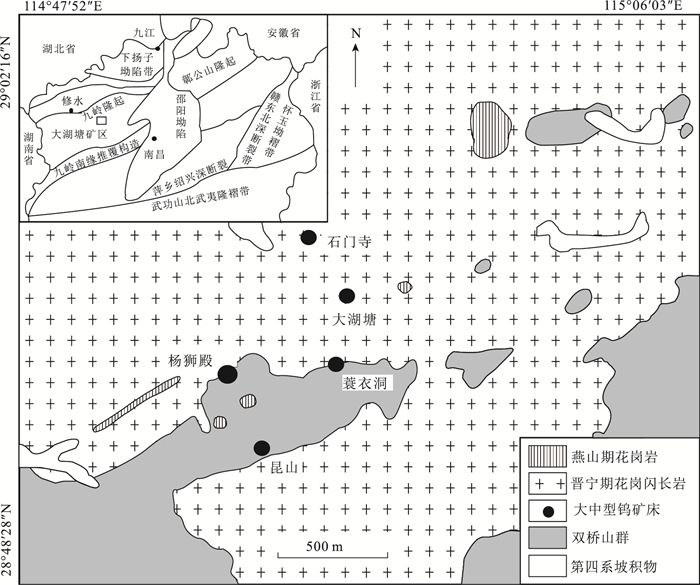
 下载:
下载:
